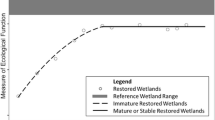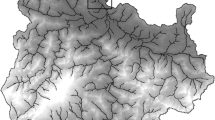Abstract
River and stream restoration projects are increasingly numerous but rarely subjected to systematic postproject evaluation. Without conducting such evaluation and widely disseminating the results, lessons will not be learned from successes and failures, and the field of river restoration cannot advance. Postproject evaluation must be incorporated into the initial design of each project, with the choice of evaluation technique based directly upon the specific project goals against which performance will be evaluated. We emphasize measurement of geomorphic characteristics, as these constitute the physical framework supporting riparian and aquatic ecosystems. Techniques for evaluating other components are briefly discussed, especially as they relate to geomorphic variables. Where possible, geomorphic, hydrologic, and ecological variables should be measured along the same transects. In general, postproject monitoring should continue for at least a decade, with surveys conducted after each flood above a predetermined threshold. Project design should be preceded by a historical study documenting former channel conditions to provide insights into the processes suggest earlier, potentially stable channel configurations as possible design models.
Similar content being viewed by others
Literature Cited
Allen, K. R. 1969. Limitations on production in salmonid populations in streams. Pages 3–18in T. G. Northcote (ed.), Symposium on salmon and trout in streams. University of British Columbia, Vancouver, British Columbia.
Barnes, H. H. 1967. Roughness characteristics of natural channels. US Geological Survey Water Supply Paper 1849, 213 pp.
Berger, J. J. 1991. A generic framework for evaluating complex restoration and conservation projects.Environmental Professional 13(3):254–262.
Bisson, P. A., J. L. Nielsen, R. A. Palmason, and L. E. Grove. 1981. A system of naming habitat types in small streams, with examples of habitat utilization by salmonids during low streamflow. Pages 62–73in N. B. Armstrong (ed.), Proceedings of a symposium: Acquisition and utilization of aquatic habitat inventory information. Western Division American Fisheries Society.
Bonham, C. D. 1989. Measurements for terrestrial vegetation. John Wiley & Sons, New York, 338 pp.
Bovee, K. D. 1982. A guide to stream habitat analysis using the instream flow incremental methodology. Instream Flow Information Paper No. 12. FWS/OBS-82/86. Cooperative Instream Flow Service Group, US Fish and Wildlife Service, Ft. Collins, Colorado, 248 pp.
California Department of Fish and Game. 1993. Request for proposals for the California Department of Fish and Game Inland Fisheries Division 1993/94 Fishery Restoration Grants Program.
Carothers, S. W., G. S. Mills, and R. R. Johnson. 1990. The creation and restoration of riparian habitat in southwestern arid and semi-arid regions. Pages 351–366in J. Kusler, and M. Kentula (eds.), Wetland creation and restoration: The status of the science. Island Press, Washington, DC.
Chanin, P. R. F. and D. J. Jeffries. 1978. The decline of the otterLutra in Britain: An analysis of hunting records and discussion of causes.Journal of the Linnean Society 10: 305–328.
Charbonneau, R., and V. H. Resh. 1992. Strawberry Creek on the University of California, Berkeley campus: A case history of urban stream restoration.Aquatic Conservation 2:293–307.
Chow, V. T. 1959. Open channel hydraulics. McGraw-Hill, New York, 680 pp.
Connin, S. 1991. Characteristics of successful riparian restoration projects in the pacific northwest. Prepared for US Environmental Protection Agency, Region 10, Water Division, Seattle, Washington, Rept. No. EPA 910/9-91-033.
Cooper-Marcus, C., and C. Francis. 1990. People places: Design guidelines for urban open space. Van Nostrand Reinhold, New York.
Dunne, T., and L. B. Leopold. 1978. Water in environmental planning. W. H. Freeman, San Francisco, 818 pp.
Erwin, K. L. 1990. Wetland evaluation for restoration and creation. Pages 429–458in J. Kusler, and M. Kentula (eds.), Wetland creation and restoration: The status of the science. Island Press, Washington, DC.
Everest, F. H., R. L. Beschta, J. C. Scrivener, K. V. Koski, J. R. Sedell, and C. J. Cederholm. 1987. Fine sediment and salmonid production: a paradox. Pages 98–142in E. O. Salo and T. W. Cundy (eds.), Streamside management: Forestry and fishery interactions. Contribution No. 57, University of Washington, Institute of Forest Resources, Seattle, Washington.
Freeze, R., and J. Cherry. 1979. Groundwater. Prentice Hall, Englewood Cliffs, New Jersey, 604 pp.
Frissell, C. A., and R. K. Nawa. 1992. Incidence and causes of physical failure of artificial habitat structures in streams of western Oregon and Washington.North American Journal of Fisheries Management 12: 182–197.
Gregory, S. V., F. J. Swanson, W. A. McKee, and K. W. Cummins. 1991. An ecosystem perspective of riparian zones: Focus on links between land and water.Bioscience 41(8):540–551.
Green, J., and R. Green. 1987. Otter survey of Scotland 1984–85. Unpublished report. Vincent Wildlife Trust, London.
Halcrow, J. 1989. A-465—Neath to Abergavenny River Neath diversions, review of diversions. Report to West Glamorgan County Council, Sir James Halcrow and Partners.
Hicks, D. M., and P. D. Mason. 1991. Roughness coefficients of New Zealand rivers. New Zealand Department of Scientific and Industrial Research, Marine and Freshwater, Water Resources Survey, 329 pp.
Holmes, N. 1991. British rivers: A working classification.Wildlife 1:20–36.
Holmes, N. 1991. Post-project appraisal of conservation enhancements of flood defence works. R & D Report 285/1/A, National Rivers Authority, Reading, UK.
Hunt, R. L. 1976. A long-term evaluation of trout habitat development and its relations to improving management-related research.Transactions of the American Fisheries Society 105:361–364.
Hunter, C. J. 1991. Better trout habitat: A guide to restoration and management. Island Press, Washington, DC, 318 pp.
Jensen, S. E., and W. S. Platts. 1990. Restoration of degraded riverine/riparian habitat in the Great Basin and Snake River regions. Pages 367–404in J. Kusler, and M. Kentula (eds.), Wetland creation and restoration: The status of the science. Island Press, Washington, DC.
Karr, J. R., and D. R. Dudley. 1981. Ecological perspective on water quality goals.Environmental Management 5: 55–68.
Kondolf, G. M. 1994. A cross section of stream channel restoration.Journal of Soil and Water Conservation (in press).
Kondolf, G. M., and S. Li. 1992. The pebble count technique for quantifying surface bed material size in instream flow studies.Rivers 3:80–87.
Kondolf, G. M., and M. J. Sale. 1985. Application of historical channel stability analysis (HCSA) to instream flow studies. Pages 184–194in F. W. Olsen, R. G. White, and R. H. Hamre (eds.), Proceedings of the Symposium on Small Hydropower and Fisheries, American Fisheries Society, Bio-Engineering Section and Western Division, 1–3 May, 1985, Denver, Colorado.
Kondolf, G. M., J. W. Webb, M. J. Sale, and T. Felando. 1987. Basic hydrologic studies for assessing impacts of flow diversions on riparian vegatation: Examples from streams of the eastern sierra Nevada, California.Environmental Management 11:757–769.
Kondolf, G. M., P. Vorster, and J. G. Williams. 1990. Hydrologic and channel stability considerations in stream habitat restoration. Pages 214–227in J. J. Berger (ed.), Environmental restoration. Island Press, Covelo, California.
Lawson, P. W. 1993. Cycles in ocean productivity, trends in habitat quality, and the restoration of salmon runs in Oregon.Fisheries 18:6–10.
Lee, D. R. and J. A. Cherry. 1978. A field exercise on groundwater using seepage meters and mini-piezometers.Journal of Geological Education 27:6–10.
Leopold, L. B. 1969. Landscape esthetics: How to quantify the scenics of a river valley.Natural History October:36–45.
Litton, R. B., Jr. 1973. Landscape control points: A procedure for predicting and monitoring visual impacts. USDA Forest Research Paper PSW-91/1973. Pacific southwest Forest and range Experiment Station, Berkeley, California.
Litton, R. B. 1984. Visual fluctuations in river landscape quality. Pages 369–383in J. S. Popadic, D. I. Butterfield, D. H. Anderson, and M. R. Popadic (eds.), 1984 National River Recreation Symposium Proceedings. Louisiana State University, School of Landscape Architecture, Baton Rouge, Louisiana.
Loar, R. M., and M. J. Sale. 1981. Analysis of environmental issues related to small-scale hydroelectric development: Instream flow needs for fishery resources. Oak Ridge National Laboratory, Environmental Sciences Division, Oak Ridge, Tennessee. Publication No. 1829, ORNL/TM-7861, 123 pp.
MacDonald, L. 1988. An inexpensive, portable system for drilling into subsurface layers.Soil Science Society of America Journal 52:1817–1819.
MacDonald, L., with A. Smart and R. Wissmar. 1991. Monitoring guidelines to evaluate effects of forestry activities on streams in the Pacific Northwest and Alaska. Developed for Region 10 US Environmental Protection Agency with Center for Streamside Studies, University of Washington, Seattle, Washington, 166 pp.
Madej, M. A., W. E. Weaver, and D. K. Hagans. 1992. Riparian vegetation as a control on channel widening.EOS 73(43):231.
Malde, H. E. 1973. Geologic benchmarks by terestrial photography.US Geological Survey Journal of Research 1:193–206.
Morrison, M. L., B. G. Marcot and R. W. Mannan. 1992. Wildlife-habitat relationships: Concepts and applications. University of Wisconsin Press, Madison, Wisconsin, 342 pp.
Mueller-Dumbois, D., and H. Ellenberg. 1974. Aims and methods of vegetation ecology. John Wiley & Sons, New York.
National Research Council. 1992. Restoration of aquatic ecosystems: Science, technology, and public policy. Committee on Restoration of Aquatic Ecosystems: Science, Technology and Public Policy, Water Science and Technology Board, Commission on Geosciences, Environment, and Resources, National Research Council. National Academy of Sciences, Washington, DC, 552 pp.
Nature Conservancy Council. 1990. Handbook for phase I survey—a technique for environmental audit. NCC England Field Unit, Peterborough, Cambridgeshire.
Neudorf, T. 1989. Evaluation of DWR urban stream restoration projects of 1987–1988. University of California, Berkeley. MLA Professional Project, Department of Landscape Architecture, 112 pp.
Nielsen, L. A., and D. L. Johnson, (eds.). 1983. Fisheries techniques. Prepared for the American Fisheries Society. Southern Printing Co., Blacksburg, Virginia, 468 pp.
O'Neil, J., and L. Fitch. 1992. Performance audit of instream habitat structures constructed during the period, 1982–1990, in southwestern Alberta. Abstracts for American Fisheries Society Meeting, September 1992, Rapid City, South Dakota, p. 4 (abstract).
Philip Williams and Associates. 1991. San Lorenzo River Enhancement Plan. Prepared with John Stanley and Associates, January 1991.
Plafkin, J. L., M. T. Barbour, K. D. Porter, S. K. Gross, and R. M. Hughes. 1989. Rapid bioassessment protocols for use in streams and rivers: Benthic macroinvertebrates and fish. US. Environmental Protection Agency, Office of Water, Washington, DC. Report No. EPA/444/4-89-001.
Platts, W. S. and Nelson, R. L. 1988. Fluctuations in trout populations and their implications for land use evaluation.North American Journal of Fisheries Management. 8:333–345.
Platts, W. S. with C. Armour, G. Booth, M. Bryant, J. Bufford, P. Cuplin, S. Jensen, G. Lienkaemper, G. Minshall, S. Monsen, R. Nelson, J. Sedell, and J. Tuhy. 1987. Methods for evaluating riparian habitats with applications to management. USFS, Intermoutain Research Station, Ogden, Utah, General Technical Report INT-221.
Rantz, S. E. 1971. Suggested criteria for hydrologic design of storm-drainage facilities in the San Francisco Bay Region, California. US Geological Survey Open-File Report, Menlo Park, California.
Rantz, S. E., and others. 1982. Measurement and computation of streamflow: Volume 1. Measurement of stage and discharge. USGS Water Supply Paper 2175, US Government Printing Office, Washington, DC, 284 pp.
Rosenberg, D., and V. H. Resh (eds). 1993). Freshwater biomonitoring and benthic macroinvertebrates. Chapman and Hall, New York.
Sandecki, M. 1989. Aggregate mining in river systems.California Geology 42:88–94.
Statzner, B., J. A. Gore, and V. H. Resh. 1988. Hydraulic stream ecology: observed patterns and potential applications.Journal of the North American Benthological Society 4:307–360.
US ACE (US Army Corps of Engineers). 1990a. HEC-2 Water surface profiles user's manual. Rept. No. CPD-2A. US ACE Hydrologic Engineering Center, Davis, California.
US ACE (US Army Corps of Engineers). 1990b. Wildcat and San Pablo Creeks, Contra Costa County, California, Reach 1 operation and maintenance manual. USACE Sacramento District, Sacramento, California.
US EPA (US Environmental Protection Agency, Office of Water). 1992. Managing non-point source pollution: Final report to Congress on section 319 of the Clean Water Act. Washington, DC.
Westman, W. E. 1991. Ecological restoration projects: Measuring their performance.Environmental Professional 13(3): 207–215.
Williams, G. P., and M. G. Wolman. 1984. Downstream effects of dams on rivers. US Geological Survey Professional Paper 1286, 83 pp.
Williams, P. B. 1990. Rethinking flood control channel design.Civil Engineering 60:57–59.
Winget, R. N. 1985. Methods for determining successful reclamation of stream ecosystems. Pages 165–192in J. A. Gore (ed.), The restoration of rivers and streams. butterworth, Boston.
Wolman, M. G. 1954. A method of sampling coarse riverbed material.Transactions of the American Geophysical Union 35(6):951–956.
Author information
Authors and Affiliations
Rights and permissions
About this article
Cite this article
Kondolf, G.M., Micheli, E.R. Evaluating stream restoration projects. Environmental Management 19, 1–15 (1995). https://doi.org/10.1007/BF02471999
Issue Date:
DOI: https://doi.org/10.1007/BF02471999




